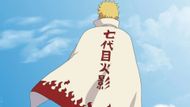When people debate Naruto Uzumaki’s performance as the Seventh Hokage, the conversation often swings between two extremes: he’s either the savior who brought about an unprecedented era of peace, or he’s an overworked leader whose flaws became more obvious in the Boruto era.
But the real evidence of his success is far less flashy, far more human, and standing right in front of us, his daughter, Himawari Uzumaki. In many ways, Himawari’s very existence, personality, and place in the world serve as living proof that Naruto accomplished something no other Hokage could.
She is the child of a Jinchuriki, yet she grows up loved, respected, and completely at ease with her heritage. That single fact alone tells us more about Naruto’s legacy than any battle he fought or policy he signed into law.

Here’s where Himawari comes in. We went from an era where Jinchuriki were reviled, to an era where the daughter of one can walk through the village wearing a T-shirt openly representing her tailed beast heritage, and nobody blinks. That cultural shift is seismic.
Himawari doesn’t have to hide who her father is. She doesn’t have to grow up lonely, suspicious of others, or constantly on guard against hate. That’s not just a personal victory for Naruto. That’s policy, culture, and community all moving forward under his leadership.
Leadership beyond war

One of the reasons people underestimate Naruto’s tenure is that he inherited a time of peace. Some say it’s easier to be Hokage when there’s no major war to fight. But that view ignores the reality of post-war leadership.
Managing peace is often more complex than managing war. Wars unite people under a common cause. Peace demands constant maintenance, diplomacy, trade, public safety, cultural reconciliation, and managing the restless energy of shinobi who no longer have constant battles to fight.
In that environment, raising children like Himawari to thrive wasn’t just a personal act; it was a sign that his broader policies were working.
The Face of the Fourth Shinobi World War

Another reason Naruto’s influence was uniquely strong is that he was the most visible hero of the Fourth Great Ninja War. Every shinobi in Naruto saw him fighting Obito, helping to free the tailed beasts, and inspiring exhausted soldiers with sheer willpower.
This credibility translated directly into the trust people placed in his vision for peace. And that trust is part of why Himawari can grow up in a Konoha where her father’s role as a Jinchuriki is celebrated rather than feared.
The weight of peace in Naruto

The analogy to the post-World War II era is a fitting one. After a massive global conflict, leaders didn’t just return to “business as usual.” They had to navigate new international systems, growing global interdependence, and the constant risk that one wrong move could reignite conflict.
Similarly, Naruto wasn’t just running Konoha; he was one of the chief architects of a peaceful shinobi world. His hyper-vigilance wasn’t paranoia - it was the informed caution of someone who had seen firsthand how quickly the cycle of hatred could restart.
That’s why he often seemed overworked. The stakes were higher, not just for the Leaf, but for the entire alliance. Every decision had potential global consequences.
Final thoughts
In the end, the true proof of his success isn’t in monuments, medals, or mission logs. It’s in the everyday life of his daughter, who represents the very change he once only dreamed of.
Himawari Uzumaki is living, breathing evidence that Naruto was more successful as Hokage than anyone gives him credit for. And in a shinobi world still healing from centuries of conflict, that may be the greatest accomplishment of all.
